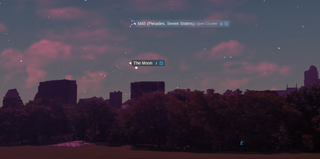
The rare five-planet alignment of 2022 remains in view through this first weekend of summer. To see it at its best, you must be up at the crack of dawn. But if you are, you'll be rewarded with what likely will be the most eye-catching celestial rendezvous between the two brightest objects in the night sky: Venus and the moon.
Considering the sun rises so early this time of year in the Northern Hemisphere, it's admittedly a little difficult getting up to view a celestial event before sunrise. On Saturday morning (June 25), the moon will rise high above and to the right of dazzling Venus.
However, if the sky is clear early Sunday morning (June 26), it will be worth your while to set your alarm clock for 60 to 90 minutes before sunrise to see the celestial dance of these two bright objects.
Related: Stargazing with binoculars: Beginner tips
Look low toward the east-northeast horizon for a view of a very thin (7% illuminated) waning crescent moon, less than three days before new phase. And situated about 2.5 degrees slightly below and to the right of this lunar sliver will be Venus.
Although the two will appear to be close together, they're quite distant: Venus is currently 128.8 million miles (207.3 million kilometers) from Earth, while the moon is about 515 times closer, at 249,900 miles (402,000 km) away.
If you have good binoculars and look early enough, while the sky is still relatively dark, scan 6.7 degrees above Venus for a view of the famous Pleiades star cluster, which is just beginning to re-emerge into view after having been hidden in the glare of the sun for the past month. (As a point of reference, a dime held at arm's length measures 2 degrees across, while your clenched fist held at arm's length measures roughly 10 degrees.)
Get the Space.com Newsletter
Breaking space news, the latest updates on rocket launches, skywatching events and more!
Venus currently rises about 12 minutes after the first light of dawn. Interestingly, though, in the coming weeks, as Venus follows the sun through the northernmost part of the ecliptic and across the constellations Taurus and Gemini, the planet will actually appear to rise within only a minute or two after the break of dawn. This will be the case during the last 10 days of July. By the final week of August, however, Venus will be rising only about 90 minutes before sunup and will be rapidly sinking lower into the bright morning twilight with each passing morning. And by the end of September, Venus will be all but gone from the morning sky.
So, in spite of the ungodly hour, arise early Sunday morning to catch a view of Venus while it is still readily visible. This rendezvous with our nearest neighbor in space will make for a lovely celestial tableau to greet you on an early summer morning.
Joe Rao serves as an instructor and guest lecturer at New York's Hayden Planetarium. He writes about astronomy for Natural History magazine, the Farmers' Almanac and other publications. Follow us on Twitter @Spacedotcom and on Facebook.
Join our Space Forums to keep talking space on the latest missions, night sky and more! And if you have a news tip, correction or comment, let us know at: community@space.com.

Joe Rao is Space.com's skywatching columnist, as well as a veteran meteorologist and eclipse chaser who also serves as an instructor and guest lecturer at New York's Hayden Planetarium. He writes about astronomy for Natural History magazine, the Farmers' Almanac and other publications. Joe is an 8-time Emmy-nominated meteorologist who served the Putnam Valley region of New York for over 21 years. You can find him on Twitter and YouTube tracking lunar and solar eclipses, meteor showers and more. To find out Joe's latest project, visit him on Twitter.
Most Popular

